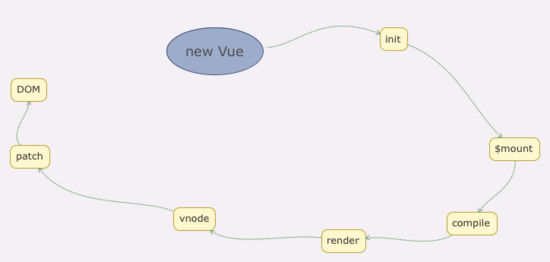这篇文章主要介绍了彻底揭秘keep-alive原理(小结),小编觉得挺不错的,现在分享给大家,也给大家做个参考。一起跟随小编过来看看吧
一、前言
原文链接: https://github.com/qiudongwei/blog/issues/4
本文介绍的内容包括:
- keep-alive用法:动态组件&vue-router
- keep-alive源码解析
- keep-alive组件及其包裹组件的钩子
- keep-alive组件及其包裹组件的渲染
二、keep-alive介绍与应用
2.1 keep-alive是什么
keep-alive是一个抽象组件:它自身不会渲染一个 DOM 元素,也不会出现在父组件链中;使用keep-alive包裹动态组件时,会缓存不活动的组件实例,而不是销毁它们。
2.2 一个场景
用户在某个列表页面选择筛选条件过滤出一份数据列表,由列表页面进入数据详情页面,再返回该列表页面,我们希望:列表页面可以保留用户的筛选(或选中)状态。keep-alive就是用来解决这种场景。当然keep-alive不仅仅是能够保存页面/组件的状态这么简单,它还可以避免组件反复创建和渲染,有效提升系统性能。 总的来说,keep-alive用于保存组件的渲染状态。
2.3 keep-alive用法 在动态组件中的应用
在vue-router中的应用
include 定义缓存白名单,keep-alive会缓存命中的组件; exclude 定义缓存黑名单,被命中的组件将不会被缓存; max 定义缓存组件上限,超出上限使用LRU的策略置换缓存数据。
三、源码剖析
keep-alive.js 内部另外还定义了一些工具函数,我们按住不表,先看它对外暴露的对象。
// src/core/components/keep-alive.js export default { name: 'keep-alive', abstract: true, // 判断当前组件虚拟dom是否渲染成真是dom的关键 props: { include: patternTypes, // 缓存白名单 exclude: patternTypes, // 缓存黑名单 max: [String, Number] // 缓存的组件实例数量上限 }, created () { this.cache = Object.create(null) // 缓存虚拟dom this.keys = [] // 缓存的虚拟dom的健集合 }, destroyed () { for (const key in this.cache) { // 删除所有的缓存 pruneCacheEntry(this.cache, key, this.keys) } }, mounted () { // 实时监听黑白名单的变动 this.$watch('include', val => { pruneCache(this, name => matches(val, name)) }) this.$watch('exclude', val => { pruneCache(this, name => !matches(val, name)) }) }, render () { // 先省略... } }可以看出,与我们定义组件的过程一样,先是设置组件名为 keep-alive ,其次定义了一个 abstract 属性,值为 true 。这个属性在vue的官方教程并未提及,却至关重要,后面的渲染过程会用到。 props 属性定义了keep-alive组件支持的全部参数。
keep-alive在它生命周期内定义了三个钩子函数:
created
初始化两个对象分别缓存VNode(虚拟DOM)和VNode对应的健集合
destroyed
删除 this.cache 中缓存的VNode实例。我们留意到,这里不是简单地将 this.cache 至为 null ,而是遍历调用 pruneCacheEntry 函数删除。
// src/core/components/keep-alive.js function pruneCacheEntry ( cache: VNodeCache, key: string, keys: Array, current?: VNode ) { const cached = cache[key] if (cached && (!current || cached.tag !== current.tag)) { cached.componentInstance.$destroy() // 执行组件的destory钩子函数 } cache[key] = null remove(keys, key) }
删除缓存VNode还要对应执行组件实例的 destory 钩子函数
mounted
在 mounted 这个钩子中对 include 和 exclude 参数进行监听,然后实时地更新(删除) this.cache 对象数据。 pruneCache 函数的核心也是去调用 pruneCacheEntry 。
render
// src/core/components/keep-alive.js render () { const slot = this.$slots.default const vnode: VNode = getFirstComponentChild(slot) // 找到第一个子组件对象 const componentOptions: ?VNodeComponentOptions = vnode && vnode.componentOptions if (componentOptions) { // 存在组件参数 // check pattern const name: ?string = getComponentName(componentOptions) // 组件名 const { include, exclude } = this if ( // 条件匹配 // not included (include && (!name || !matches(include, name))) || // excluded (exclude && name && matches(exclude, name)) ) { return vnode } const { cache, keys } = this const key: ?string = vnode.key == null // 定义组件的缓存key // same constructor may get registered as different local components // so cid alone is not enough (#3269) ? componentOptions.Ctor.cid + (componentOptions.tag ? `::${componentOptions.tag}` : '') : vnode.key if (cache[key]) { // 已经缓存过该组件 vnode.componentInstance = cache[key].componentInstance // make current key freshest remove(keys, key) keys.push(key) // 调整key排序 } else { cache[key] = vnode // 缓存组件对象 keys.push(key) // prune oldest entry if (this.max && keys.length > parseInt(this.max)) { // 超过缓存数限制,将第一个删除 pruneCacheEntry(cache, keys[0], keys, this._vnode) } } vnode.data.keepAlive = true // 渲染和执行被包裹组件的钩子函数需要用到 } return vnode || (slot && slot[0]) }第一步:获取keep-alive包裹着的第一个子组件对象及其组件名;
第二步:根据设定的黑白名单(如果有)进行条件匹配,决定是否缓存。不匹配,直接返回组件实例(VNode),否则执行第三步;
第三步:根据组件ID和tag生成缓存Key,并在缓存对象中查找是否已缓存过该组件实例。如果存在,直接取出缓存值并更新该 key 在 this.keys 中的位置(更新key的位置是实现LRU置换策略的关键),否则执行第四步;
第四步:在 this.cache 对象中存储该组件实例并保存 key 值,之后检查缓存的实例数量是否超过 max 的设置值,超过则根据LRU置换策略删除最近最久未使用的实例(即是下标为0的那个key)。
第五步:最后并且很重要,将该组件实例的 keepAlive 属性值设置为 true 。这个在 @ 不可忽视:钩子函数 章节会再次出场。
四、重头戏:渲染
4.1 Vue的渲染过程
借一张图看下Vue渲染的整个过程:

Vue的渲染是从图中的 render 阶段开始的,但keep-alive的渲染是在patch阶段,这是构建组件树(虚拟DOM树),并将VNode转换成真正DOM节点的过程。
简单描述从 render 到 patch 的过程
我们从最简单的 new Vue 开始:
import App from './App.vue' new Vue({ render: h => h(App), }).$mount('#app')- Vue在渲染的时候先调用原型上的
_render函数将组件对象转化为一个VNode实例;而_render是通过调用createElement和createEmptyVNode两个函数进行转化; createElement的转化过程会根据不同的情形选择new VNode或者调用createComponent函数做VNode实例化;- 完成VNode实例化后,这时候Vue调用原型上的
_update函数把VNode渲染为真实DOM,这个过程又是通过调用__patch__函数完成的(这就是pacth阶段了)
用一张图表达:

4.2 keep-alive组件的渲染
我们用过keep-alive都知道,它不会生成真正的DOM节点,这是怎么做到的?
// src/core/instance/lifecycle.js export function initLifecycle (vm: Component) { const options = vm.$options // 找到第一个非abstract的父组件实例 let parent = options.parent if (parent && !options.abstract) { while (parent.$options.abstract && parent.$parent) { parent = parent.$parent } parent.$children.push(vm) } vm.$parent = parent // ... }Vue在初始化生命周期的时候,为组件实例建立父子关系会根据 abstract 属性决定是否忽略某个组件。在keep-alive中,设置了 abstract: true ,那Vue就会跳过该组件实例。
keep-alive包裹的组件是如何使用缓存的?
在 patch 阶段,会执行 createComponent 函数:
// src/core/vdom/patch.js function createComponent (vnode, insertedVnodeQueue, parentElm, refElm) { let i = vnode.data if (isDef(i)) { const isReactivated = isDef(vnode.componentInstance) && i.keepAlive if (isDef(i = i.hook) && isDef(i = i.init)) { i(vnode, false /* hydrating */) } if (isDef(vnode.componentInstance)) { initComponent(vnode, insertedVnodeQueue) insert(parentElm, vnode.elm, refElm) // 将缓存的DOM(vnode.elm)插入父元素中 if (isTrue(isReactivated)) { reactivateComponent(vnode, insertedVnodeQueue, parentElm, refElm) } return true } } }在首次加载被包裹组件时,由 keep-alive.js 中的 render 函数可知, vnode.componentInstance 的值是 undefined , keepAlive 的值是 true ,因为keep-alive组件作为父组件,它的 render 函数会先于被包裹组件执行;那么就只执行到 i(vnode, false /* hydrating */) ,后面的逻辑不再执行;
再次访问被包裹组件时, vnode.componentInstance 的值就是已经缓存的组件实例,那么会执行 insert(parentElm, vnode.elm, refElm) 逻辑,这样就直接把上一次的DOM插入到了父元素中。
五、不可忽视:钩子函数
5.1 只执行一次的钩子
一般的组件,每一次加载都会有完整的生命周期,即生命周期里面对应的钩子函数都会被触发,为什么被keep-alive包裹的组件却不是呢? 我们在 @ 源码剖析 章节分析到,被缓存的组件实例会为其设置 keepAlive = true ,而在初始化组件钩子函数中:
// src/core/vdom/create-component.js const componentVNodeHooks = { init (vnode: VNodeWithData, hydrating: boolean): ?boolean { if ( vnode.componentInstance && !vnode.componentInstance._isDestroyed && vnode.data.keepAlive ) { // kept-alive components, treat as a patch const mountedNode: any = vnode // work around flow componentVNodeHooks.prepatch(mountedNode, mountedNode) } else { const child = vnode.componentInstance = createComponentInstanceForVnode( vnode, activeInstance ) child.$mount(hydrating ? vnode.elm : undefined, hydrating) } } // ... }可以看出,当 vnode.componentInstance 和 keepAlive 同时为truly值时,不再进入 $mount 过程,那 mounted 之前的所有钩子函数( beforeCreate 、 created 、 mounted )都不再执行。
5.2 可重复的activated
在 patch 的阶段,最后会执行 invokeInsertHook 函数,而这个函数就是去调用组件实例(VNode)自身的 insert 钩子:
// src/core/vdom/patch.js function invokeInsertHook (vnode, queue, initial) { if (isTrue(initial) && isDef(vnode.parent)) { vnode.parent.data.pendingInsert = queue } else { for (let i = 0; i 再看 insert 钩子:
// src/core/vdom/create-component.js const componentVNodeHooks = { // init() insert (vnode: MountedComponentVNode) { const { context, componentInstance } = vnode if (!componentInstance._isMounted) { componentInstance._isMounted = true callHook(componentInstance, 'mounted') } if (vnode.data.keepAlive) { if (context._isMounted) { queueActivatedComponent(componentInstance) } else { activateChildComponent(componentInstance, true /* direct */) } } // ... }在这个钩子里面,调用了 activateChildComponent 函数递归地去执行所有子组件的 activated 钩子函数:
// src/core/instance/lifecycle.js export function activateChildComponent (vm: Component, direct?: boolean) { if (direct) { vm._directInactive = false if (isInInactiveTree(vm)) { return } } else if (vm._directInactive) { return } if (vm._inactive || vm._inactive === null) { vm._inactive = false for (let i = 0; i 相反地, deactivated 钩子函数也是一样的原理,在组件实例(VNode)的 destroy 钩子函数中调用 deactivateChildComponent 函数。
参考
以上就是本文的全部内容,希望对大家的学习有所帮助,也希望大家多多支持html中文网。
以上就是彻底揭秘keep-alive原理(小结)的详细内容,更多请关注0133技术站其它相关文章!








